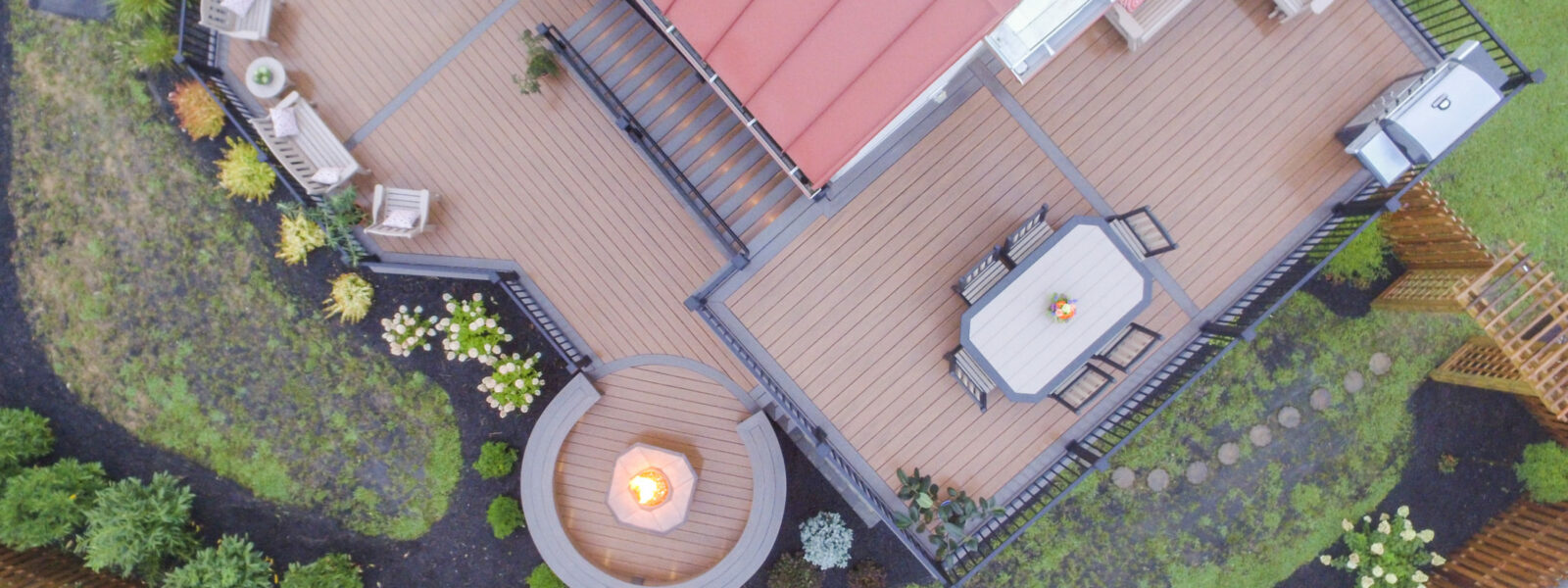Bigger is better, right? Well, it depends.
When considering how big of a deck you are looking to build, you have to consider what you need from the space, the size of the yard where the deck will be built, what your budget is, as well as the limitations on constructions in your community. With that in mind, here are some good initial questions to ask yourself while planning your new deck.
What Do I Want to Use My Deck For?
Are you looking for a quiet oasis outside for you and your family or are you hoping to hold larger get togethers and you want to use your deck for entertaining?
Keep in mind that you’ll need about 144 square feet of space for 4 to 6 people to eat out outside. If you’re looking to feed 10 to 12 people, you’re looking at 288 square feet. But that doesn’t include space for people to circle around. So if you want to have a space where people can stand and talk, you will need more space than that. 392 square feet is often considered a good space for larger-scale entertaining.
However, keep in mind that this does not include additional structures. If you also want to include outdoor cooking space, you need to add that space to the square footage. If you are installing a hot tub or a fire pit, again, you will need additional space.

How Much Weight is My Deck Supporting?
You also have to consider if your deck needs to be designed to support heavy equipment like an outdoor kitchen. The increased load will also increase the cost.
Keep in mind, there is a difference between “dead load” and “live load.” The dead load is the weight of the deck itself, and typically comes in at 10 pounds per square foot. The live load is the weight of people, furniture, and appliances. This usually tops out at 40 pounds per square foot. Thus, the total design load will be 50 pounds per square foot.
But items like a hot tub or a large outdoor kitchen will increase the design load. You need to plan out these things ahead of time, because heavy items that will increase the live load of the deck cannot be added later if the structure is not built to support them.
How Much Yard Do I Have?
Keep in mind that if your deck is on the ground floor, every square foot of deck will remove a square foot of yard. Maybe that’s a perk, especially if you hate mowing or if you can’t grow grass well in your yard. However, if you have kids who like to play in the yard, you want to make sure that you are preserving enough space for them to enjoy the grass.
If you are building a second-floor deck, you may be able to conserve more yard space. Just remember that the shady area under the deck will likely become unsuitable for grass growth.
How will Environmental Conditions Influence the Structure?
A number of environmental factors will determine the load bearing capability of your deck structure. For example, the amount of load that your deck can support with depend on the soil type. Different soil types are more stable than others.
Additionally, here in Pennsylvania, we often have heavy snows. Decks need to be able to hold that additional load. While people are less likely to spend time on their decks during the winter, if heavy snow arrives in the middle of the season, it may be a while before it melts.
How Much do I Want to Spend?
Of course, the bigger the deck, the higher the cost. And you can’t just multiply square footage by the cost of the decking lumber. Larger decks require stronger supports and more concrete anchors. That means as the deck grows, the cost of the supporting structure increases.
Additionally, larger decks will require increased maintenance, depending on the decking materials that you choose. If you are choosing a traditional wooden surface, you will need to invest in regular cleaning as well as occasional re-staining. Again, this is an added cost.
What do Local Building Codes Require?
One important aspect of any local building code is the mandated setback. Different municipalities have different requirements for how much space you have to leave between your structures and your property line. You cannot build your deck all the way to the border with your neighbor’s yard. It is your responsibility to make sure that you do not violate these regulations.
Additionally, both municipal and neighborhood regulations may limit the overall size of your deck, regardless of how close it gets to the property line. Generally speaking, most neighborhoods have fewer limits on decks built in backyards than those added to the fronts of properties. Regardless, make sure that you are in compliance with all codes and regulations before beginning a deck building project.
If all of this seems daunting, don’t worry.
These are the kinds of design issues that professional contractors are trained to handle. Here at Integrous, we pride ourselves as deck experts with years of experience tackling even the most demanding design constraints. We do everything with a personal touch, meaning we are ready to partner with you to make sure you get everything you want out of your new deck, all while ensuring that your structure is safe, long-lasting, and up-to-code.
So if you are wondering just how big of a deck to build for you and your family’s needs, contact Integrous today!

